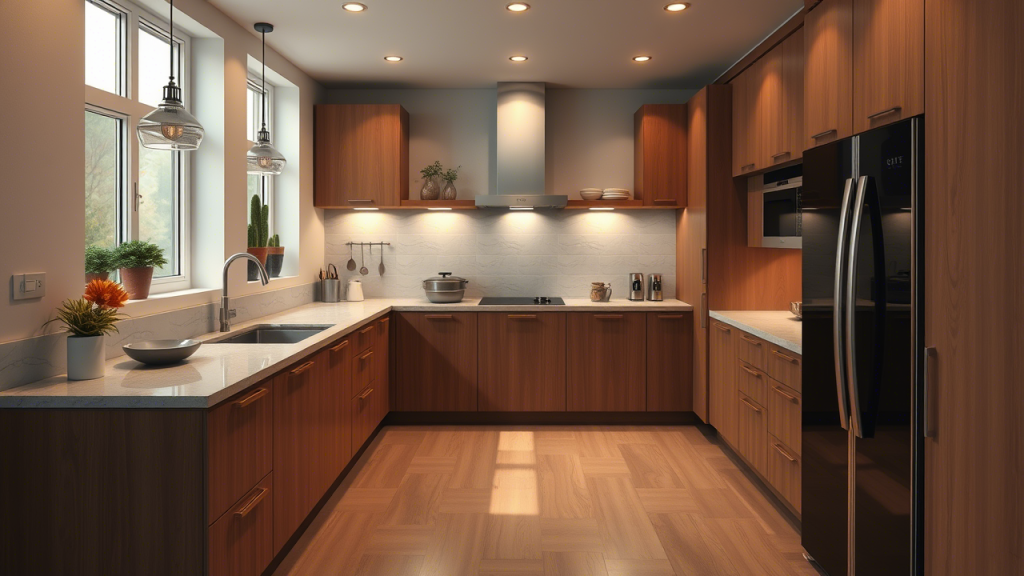A well-designed kitchen is more than just beautiful—it’s functional, efficient, and tailored to the way you live. Whether you\'re starting from scratch or updating an existing space, thoughtful design is what transforms a remodel into a long-lasting improvement. This stage is where aesthetics meet usability, where traffic flow, workspace, and storage all come together to create a kitchen that works as great as it looks.
Design and layout decisions shape every part of the remodel that follows. From determining the overall footprint to choosing where appliances and work zones are placed, this phase is foundational. A strong layout sets the tone for comfort, efficiency, and daily functionality.
1. The Kitchen Work Triangle
A foundational principle in kitchen design, the kitchen work triangle is all about optimizing movement and workflow between three key zones: the sink, the refrigerator, and the cooking area (typically the stove or cooktop). This concept dates back to the early 20th century and remains a gold standard in kitchen planning for both efficiency and comfort.
Purpose of the Work Triangle
The goal of the work triangle is to reduce unnecessary steps and improve the overall flow of movement during common kitchen tasks—cooking, cleaning, and food storage. Ideally:
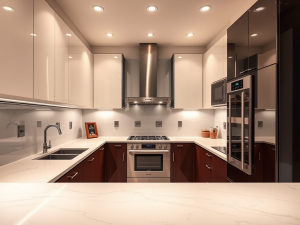
- Each leg of the triangle should measure between 4 and 9 feet.
- The total perimeter of the triangle should be between 13 and 26 feet.
- No major traffic flow should cut through the triangle.
- Obstacles like islands or tall cabinetry should not obstruct movement between the points.
Adapting the Triangle to Modern Needs
Today’s kitchens often serve more than just cooking functions—they’re gathering places, home offices, and homework stations. As such, the traditional triangle may evolve into work zones that accommodate multiple users or tasks.
For example:
- In an open-concept layout, an island might serve as both prep space and a social hub.
- In a multi-cook kitchen, additional prep sinks or cooking zones may complement the main triangle.
- Smart appliances and built-in features can shift the location or functionality of triangle points.
Common Pitfalls to Avoid
While adapting the work triangle, it’s important to avoid layout mistakes that disrupt functionality, such as:
- Placing the sink too far from the stove or fridge
- Installing the dishwasher too close to a corner, preventing smooth opening
- Creating bottlenecks in high-traffic areas
- Ignoring the need for countertop space adjacent to appliances
A well-designed triangle can make everyday kitchen tasks smoother and more enjoyable, regardless of the kitchen’s size or style.
2. Layout Types
The layout of a kitchen is one of the most important decisions in any remodeling project. It dictates not only how the space looks but also how efficiently it functions. The right layout balances traffic flow, storage, appliance placement, and usability. Each layout type has its own advantages and is best suited for specific kitchen sizes, household dynamics, and cooking habits.
Let’s explore the most common kitchen layout types in detail:
1. Galley Kitchen
A galley kitchen, also known as a corridor kitchen, features two parallel runs of cabinets and countertops, creating a narrow, efficient workspace.
Best For: Smaller homes, apartments, and serious cooks who prioritize function over form.
Advantages:
- Extremely efficient for cooking due to minimal movement between stations.
- Easy to \"zone\" into prep, cooking, and cleaning areas.
- Great for tight spaces.
Considerations:
- Can feel enclosed if not properly lit.
- Limited space for dining or social interaction.
- It can become congested if used by multiple people at once.
2. L-Shaped Kitchen
An L-shaped kitchen arranges cabinets and appliances along two adjoining walls, forming an L configuration.
Best For: Medium to large kitchens and open-concept spaces.
Advantages:
- Open flow and easy traffic management.
- Allows for the addition of an island or dining table.
- Naturally accommodates the work triangle.
Considerations:
- Corner storage can be difficult; solutions like lazy Susans or blind corner pullouts are helpful.
- Appliance placement needs careful planning to maintain triangle efficiency.
3. U-Shaped Kitchen
A U-shaped kitchen features cabinetry along three walls, enclosing the user in a U-like configuration.
Best For: Larger kitchens or households that need a high-functioning workspace.
Advantages:
- Maximizes storage and counter space.
- Provides a clear separation of zones (prep, cook, clean).
- Excellent for multiple users when designed properly.
Considerations:
- Can feel closed off if upper cabinets line all three walls.
- Not ideal for open-concept living without strategic design changes (e.g., removing upper cabinets or one wall).
4. Island Kitchen
A kitchen with an island incorporates a freestanding countertop in the center of the space. Islands can function as prep areas, cooking stations, seating, or all of the above.
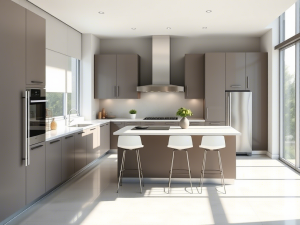
Best For: Medium to large kitchens with enough clearance around the island (minimum of 36\"–42\" on all sides).
Advantages:
- Provides extra counter and storage space.
- Ideal for social interaction and entertaining.
- Can house sinks, cooktops, or dishwashers for added functionality.
Considerations:
- Requires careful planning to avoid disrupting workflow.
- Must ensure proper clearance for walking and appliance doors.
- Plumbing or electrical installation in an island can increase costs.
5. Peninsula Kitchen
A peninsula layout is similar to an island, but the additional counter space is attached to a wall or base cabinet rather than freestanding.
Best For: Smaller spaces where a full island isn’t feasible.
Advantages:
- Adds extra counter space and seating without requiring additional square footage.
- It can create a semi-open barrier between the kitchen and adjacent living areas.
- Useful for zoning in open floor plans.
Considerations:
- May create bottlenecks if not enough clearance is provided.
- Less flexible than a freestanding island in terms of layout changes.
6. Open-Concept Kitchen
An open-concept kitchen removes walls to blend the kitchen with adjacent living or dining areas, creating one large, cohesive space.
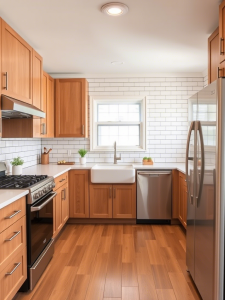
Best For: Modern lifestyles focused on entertaining and family interaction.
Advantages:
- Enhances natural light and a sense of spaciousness.
- Improves flow and visual connection with other living areas.
- Ideal for entertaining and multitasking.
Considerations:
- Less wall space for cabinets and appliances.
- Noise, odors, and mess are more visible from other parts of the home.
- Requires thoughtful layout planning to maintain zoning and structure.
Each kitchen layout has its strengths. The best option depends on your space, habits, and lifestyle. A well-chosen layout lays the foundation for a kitchen that not only looks great but works beautifully for years to come.
3. Ergonomics & Accessibility
Modern kitchen design isn’t just about aesthetics—it’s also about comfort, usability, and long-term functionality. Ergonomics and accessibility play a critical role in creating a kitchen that works with the people using it, not against them. A well-designed kitchen should minimize strain, improve efficiency, and accommodate users of all ages and physical abilities.
This becomes especially important in homes where aging in place, multi-generational living, or long cooking sessions are considerations.
What is Ergonomics in Kitchen Design?
Ergonomics refers to designing the kitchen to fit the human body and its movements—reducing bending, reaching, lifting, and twisting. The goal is to create a more intuitive, comfortable workspace.
Key ergonomic design principles:
- Countertop Height: Standard counter height is around 36 inches, but this may be adjusted based on user height. Consider lowering prep areas to 30–34 inches for shorter users or seated accessibility.
- Work Zones: Group related tasks together—prep zone, cooking zone, cleaning zone—so everything is within reach, reducing back-and-forth movement.
- Minimize Reaching: Store frequently used items between waist and shoulder height. Avoid placing heavy items in high cabinets or low drawers.
- Appliance Placement:
- Wall ovens at waist height eliminate the need to bend.
- Dishwashers installed slightly off the floor reduce strain.
- Microwave placement at or just below shoulder height improves safety.
Universal Design & Accessibility
Accessibility ensures that a kitchen is usable by people with limited mobility, including wheelchair users, the elderly, or those with other physical impairments. This is where universal design principles come in—creating a kitchen that’s accessible for everyone, regardless of ability, without needing adaptation later on.
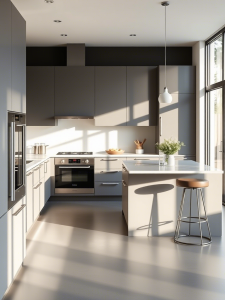
Accessibility considerations include:
- Clearance Space: At least 42\" of clearance between counters (ideally 48\") allows for easy movement, including wheelchair turning radiuses.
- Open Knee Spaces: Open areas below sinks or counters allow seated users to work comfortably. Protective insulation should cover exposed plumbing to avoid burns or injury.
- Lower Cabinets & Pull-Out Shelves: Replace deep lower cabinets with drawers or pull-outs for easy access.
- Lever Handles: Easier to use than knobs for both faucets and cabinets.
- Touch or Voice-Activated Fixtures: Great for users with limited dexterity or grip strength.
- Lighting: Under-cabinet lights, task lighting, and motion sensors enhance visibility and reduce accidents.
Future-Proofing the Kitchen
Even if no one in the household currently needs accessibility features, planning ahead with an age-in-place design can save time and money later. Features like wide doorways, non-slip flooring, and adaptable workstations make the space safer and more flexible over time.
Mistakes to Avoid
- Overhead Microwaves: They may look sleek, but are hard to reach safely for many users.
- Deep Corner Cabinets Without Organizers: These become black holes—wasted space that’s hard to access.
- Too Much Open Shelving: Reaching for dishes constantly, especially at high levels, can become a daily strain.
- Lack of Toe Kicks or Edge Relief: Cabinets should allow space at the base for your feet when standing close—this reduces back strain.
An ergonomic, accessible kitchen doesn\'t just improve comfort—it enhances safety, reduces fatigue, and extends the usable life of the space for everyone in the home. Whether you\'re building for current needs or planning for the future, designing with both ergonomics and accessibility in mind adds value in every sense.
4. Flow & Functionality
A beautiful kitchen means little if it doesn’t function smoothly. Flow refers to how easily you can move through and work within the space, while functionality focuses on how well the kitchen supports daily tasks—from prepping meals to storing essentials.
Understanding Flow
Flow refers to the movement through the kitchen. It should feel seamless, allowing one or more people to cook, clean, serve, and gather without running into one another—or into poorly placed cabinetry or appliances.
Key elements of good flow include:
- Clear walkways: Paths between cabinets and islands should be a minimum of 36 inches wide (42–48 inches for multiple cooks).
- Unobstructed work zones: Each zone (prep, cook, clean, store) should have adequate room to function independently, even when more than one person is using the kitchen.
- Logical progression of use: For example, a prep area placed between the fridge and the cooktop ensures a natural cooking process—get ingredients → prep → cook.
Functional Zones
Modern kitchen design often shifts from the classic work triangle to functional zones. These are task-based areas that optimize efficiency by clustering similar activities together.
Here are the most common functional zones:
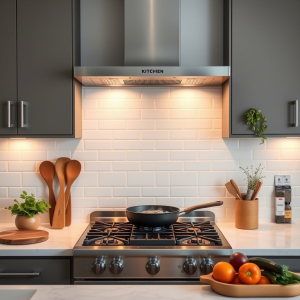
- Prep Zone
Located near the refrigerator and sink, it should have ample counter space, access to knives, mixing bowls, and cutting boards. - Cooking Zone
Includes the stove or cooktop, oven, and possibly a microwave. It should be close to the pot drawers, cooking utensils, spices, and oils. - Cleaning Zone
Centered around the sink and dishwasher. Needs counter space for stacking dishes and nearby trash/recycling bins. - Storage Zone
Houses pantry goods, canned items, dry food, and bulk purchases. It should be easily accessible from both prep and cooking zones. - Serving & Entertaining Zone
Often near the dining area or island with seating, this space may include a beverage center or snack drawer for casual entertaining.
When these zones are clearly defined and integrated, the kitchen begins to operate more like a system—everything has a place, and every movement has a purpose.
Addressing Common Traffic & Workflow Issues
Poor functionality often stems from minor oversights:
- Refrigerator too far from the prep area
Causes excess walking and disjointed workflow. - Trash bins hidden behind busy cabinets
Disrupts cleanup, especially during meal prep. - Microwave door swings into traffic paths
Interrupts flow and becomes a hazard. - Overcrowded or underutilized islands
Large islands look impressive but can block circulation if not carefully planned.
Solving these issues involves balancing proximity, purpose, and practicality—all tailored to the household’s specific habits and kitchen size.
Dual-Purpose Spaces
Many kitchens now serve as multi-use spaces: work-from-home hubs, homework zones, entertaining areas, and more. Designing with this in mind means integrating flexible elements:
- Charging stations and USB outlets
- Under-counter seating for casual dining or laptops
- Sliding panels or pocket doors to hide mess or separate functions
- Integrated storage for non-kitchen items like office supplies or school materials
By anticipating these needs, you create a kitchen that adapts—not one that needs constant reconfiguration.
5. Bringing It All Together
A kitchen that flows well feels effortless. Thoughtful layout choices, strategic zoning, and functional storage create a space that works hard every day. These elements become even more important in high-traffic kitchens or when planning for long-term use.
At Jerry Polich Construction LLC, we specialize in designing and remodeling kitchens that are not only stunning but also deeply functional. If you're planning a kitchen remodeling our team will guide you from initial layout planning through to final installation—ensuring every element supports the way you live and cook.
Remember, your dream Kitchen is just a phone call away. Don’t wait—contact us now for a free consultation, and let’s start your transformation today!

